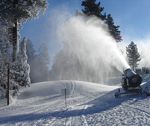 After a decade of planning and years of being on hold, Arizona Snowbowl is moving forward with snowmaking. On Dec. 1, the Federal District Court ruled that the U.S. Forest Service adequately considered the safety of reclaimed water in regards to snowmaking at the ski area. Flagstaff Business News conducted an exclusive interview with General Manager J.R. Murray on Dec. 20 to learn Arizona Snowbowl’s next steps.
After a decade of planning and years of being on hold, Arizona Snowbowl is moving forward with snowmaking. On Dec. 1, the Federal District Court ruled that the U.S. Forest Service adequately considered the safety of reclaimed water in regards to snowmaking at the ski area. Flagstaff Business News conducted an exclusive interview with General Manager J.R. Murray on Dec. 20 to learn Arizona Snowbowl’s next steps.
“We started planning for the project in 2001. In order to submit a detailed proposal to the Forest Service, we had to know quite a bit about the project. We selected the snow- making equipment supplier and the design engineer then,” explained Murray.
Snow Machines Inc. (SMI), a global supplier of snowmaking equipment based in the United States, was chosen for their expertise. SMI has served over 800 ski resorts around the world and recent projects include snowmakng at Vail, Big Bear, Calif. and the upcoming Winter Olympics in Russia.
The design package for the water supply pump stations and pipeline was executed by Torrent Engineering, another renowned snowmaking expert located in the U.S. They also engineered the complete on-mountain snowmaking system design for Arizona Snowbowl.
The City of Flagstaff agreed to sell Arizona Snowbowl certified A+ reclaimed water for snowmaking. The water will be pumped through an underground supply line to a reservoir to be built above Sunset Lift. According to Murray, the pipeline will follow Snowbowl Road and cut through the forest as it nears the ski area.
The water is held at the reservoir until it is needed and then is pumped to fan guns that blow snow to only the ski runs requiring coverage. “The computerized snowmaking equipment will be set to put down two feet of snow on designated trails and then will maintain that two-foot level. When it snows and keeps the level at two feet, we won’t have to make snow,” said Murray.
Arizona Snowbowl’s system includes integrated weather stations that monitor climatic conditions for optimizing snow production and water conservation. “It is a turn-key automated system. Arizona Snowbowl’s snowmaking will be the newest and most sophisticated system in the United States,” extolled Murray.
“Our system is designed to open the ski area and handle the existing capacities with no natural snow,” said Murray. In the first phase, snowmakers will cover 134 acres, although Arizona Snowbowl has approval to make snow on 205 acres. Runs with snowmaking include all the runs serviced by Aspen, Hart Prairie and Sunset chairlifts and all runs except “Tiger” below Midway on the Agassiz lift. “We have approval to make snow above Midway,” said Murray, who explained that many don’t realize that the acreage above Midway is only 10 percent of the total ski area.
“We are in the final stages of planning and engineering and we’re moving into project coordination. With the recent lawsuits, we put the whole project on hold back in 2008.
At this point, we’ve only had 20 days to dust everything off and get back to work on it. “We are now developing scope of work and project components. The actual selection of contractors will be in the first quarter of 2011,” predicted Murray. The next phase is broken down into six elements: trail construction, water supply line, reservoir, snowmaking infrastructure at each trail, construction of pump house buildings and electrical/power supplies.
“This will be a demanding project timewise – we intend to start and finish it in eight months,” said the general manager, who plans on operating the snowmaking system by November 2011.
In Big Bear, Calif., the SMI snowmaking system is saving energy costs over previous equipment. “Compared to traditional air-water snow guns, this SMI design is much more self-contained,” said Bob Sokolowski of Big Bear Resorts. “In most conditions, they can deliver far more snow per unit of power,” he explained. “We estimate that the amount of energy needed to operate just three air-water guns can now run TEN of the new fan guns.” The upgrade also means that the ski area uses about 30 percent less diesel fuel for generators, helping to reduce their environmental footprint. The California ski resort has been making snow since 1964 and so is typically open for Thanksgiving, according to Sokolowski.
Job Creation and Retention
“Right now we have over 400 employees ready to go to work,” said Murray. But on Dec. 20, he was not sure the ski area would be open for Christmas. “Snowmaking would ensure steady work for all those people throughout the winter. We absorb a lot of unemployed and underemployed people once we open. If you’re a river runner or a hotshot firefighter or outfitter, you maybe have to go somewhere else to get work for the winter. With snowmaking, we can provide employment and those people can stay in Flagstaff for the winter.
“The objective of this extensive system is to create a sustainable business plan. To be sustainable, we need to have an average of 2,000 people a day. With over six million people in Arizona and only two ski areas, we know that the demand for winter recreation exceeds the supply.
“The marketplace will come to understand that you can count on going to Flagstaff for skiing during Christmas break and that you don’t have to [worry about] the weather.”
Murray revealed that 25 percent of Snowbowl’s annual business comes during the December holidays. “We know that the demand is there. Last year, in a down economy, we had our best year ever.”
“Arizona Snowbowl is over 70 years old; the addition of snowmaking will ensure that it will still be open 10 to 20 years from now,” Murray explained. FBN
(Meanwhile, the Save the Peaks Coalition has filed an injunction to stop construction. The injunction was filed Tuesday and is now in the 9th Circuit U.S. Court of Appeals, with action expected in April.)







